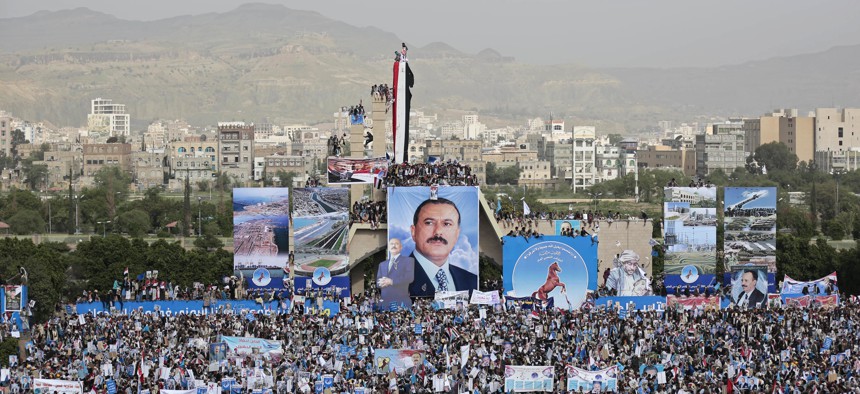
Supporters of former Yemeni President Ali Abdullah Saleh attend a ceremony to celebrate the 35th anniversary of the founding of the Popular Conference Party, in Sanaa, Yemen, Thursday, Aug. 24, 2017. Hani Mohammed/AP
Congress Should Do Its Job, and Get Us Out of Yemen’s Civil War
American support for the Saudi-led coalition is getting us nowhere good.
In mid-August, news broke of the existence of a confidential United Nations report that accused the Saudi-led air coalition intervening in Yemen’s civil war of killing hundreds of children. In the last year alone, the report said, Saudi-led forces killed or injured 683 Yemeni children. And overall, more than half of all Yemeni civilian casualties since the war began have resulted from attacks carried out by Saudi aircraft, according to an earlier report from Amnesty International.
President Obama’s administration, and now President Trump’s, provides the Saudis with intelligence and logistical support, and refuels their fighters in the air over Yemen, allowing Saudi warplanes to fly longer sorties and drop more bombs. At America’s base in Djibouti, Saudi operators launch American-made Reaper drones. But why is Saudi Arabia in Yemen, and why is Washington backing the Saudi-led coalition?
Yemen, home to more than 25 million people, is a rectangular strip of land south of Saudi Arabia on the Arabian Peninsula. For well over a century, Yemen was split in two—North Yemen and its predominately Zaydi Shiite population were part of the Ottoman Empire until the early 20th century, while South Yemen and its majority Shafi’i Sunni population were under British control until the mid-20th century. In 1990, the country was unified after a war between North and South.
Though the unified Yemen experienced bouts of strife, it was relatively subdued by strongman Ali Abdullah Saleh until the Arab Spring protests of 2011. Partly as a result of international pressure, Saleh was forced out, and his deputy, Abdrabbuh Mansur Hadi, took the reins of power.
Under Hadi, a Sunni from what was once South Yemen, an already weak government grew weaker. Al-Qaeda in the Arabian Peninsula, or AQAP, began to flourish, and the Houthis—armed forces made up mostly of Shiite fighters—pushed into the capital. By early 2015, Yemen was in a full-blown civil war.
The fight quickly devolved into a proxy war, with the Houthis backed by Shia Iran and the pro-Hadi Sunnis backed by the mostly-Sunni nations of Saudi Arabia, Bahrain, Egypt, Kuwait, Sudan, and the United Arab Emirates. As noted, the United States has aided Saudi Arabia’s bombing campaign, and sold the Saudi government more than $100 billion in arms since the fighting began.
The history matters
Today, the U.S. is supporting a Saudi effort to reunify a country that has a short, tenuous history of unification. Worse, studies of civil wars show that intervention by outside powers on both government and rebel sides tends to prolong war rather than end violence, as each side is less willing to negotiate and neither side can attain a decisive victory.
Hadi, emboldened by Saudi support, has refused to come to terms unless the Houthi rebels capitulate. The Houthis, an underdog fighting the regional power, have predictably turned to Iran for help. They would be mad to lay down their arms and hope for Hadi’s mercy. (The weak strongman has already sentenced many rebel leaders to death in absentia.)
The fighting, which has left tens of thousands killed or injured, has also delivered little change in territory. The area occupied by the Houthis looks a lot like North Yemen pre-1990 unification, and the area occupied by Hadi loyalists looks a lot like the old borders of South Yemen.
With the Trump administration considering deeper engagement in yet another Middle East civil war, Congress must do its job and vote on whether to authorize further military assistance for Saudi Arabia’s war.
Earlier this year, Sens. Rand Paul, R-Ky., and Chris Murphy, D-Conn., proposed legislation that would require the president, before approving further air-to-ground arms sales to Riyadh, to certify that the Saudis are 1) targeting terror groups, 2) minimizing civilian casualties, and 3) facilitating humanitarian assistance. Despite ample evidence that the Saudis have missed across the board, the measure failed narrowly.
Proponents of intervention give three reasons for the U.S. involvement:
- First, it is thought that Iran is expanding its influence and must be countered. But the Houthis are not an Iranian proxy, and are largely tied to Iran as a matter of expedience. If Arab-nationalism can exist in Shia Iraq, it can certainly flourish among the Houthis, who practice a form of Shia Islam distinct from the Shias in Iraq and Iran.
- Second, it is argued that U.S. assistance is crucial to defeating AQAP jihadists in southern and eastern Yemen. This ignores the facts. The U.S. can still go after AQAP without helping the Saudis fight the Houthis, as AQAP is not in Houthi-controlled areas, but is in areas supposedly controlled by pro-Hadi forces. There is even evidence that Saudi Arabia has turned a blind eye to AQAP in the past, allowing the group to control a significant amount of territory. Unconditional American aid only encourages further Saudi apathy towards AQAP.
- The final reason offered for our continued support of the Saudi war is that, through treating the Houthis as a client-state, Iran hopes to gain a strategic chokehold over the Mandeb Strait, a narrow waterway linking the Red Sea with the Gulf of Aden through which much of the world’s crude shipments pass. Protecting the global commons and America’s prosperity is a legitimate U.S. interest, but this can be achieved without ceding the moral high ground.
The solution here is a political division and peace, where Yemen’s Sunnis and Hadi keep the land adjacent to the Gulf of Aden, including the all-important Mandeb Strait, while the Houthis keep the northwest of the country bordering the Red Sea. The first step in this direction is ending our assistance to the Saudis’ indiscriminate bombing campaign.



